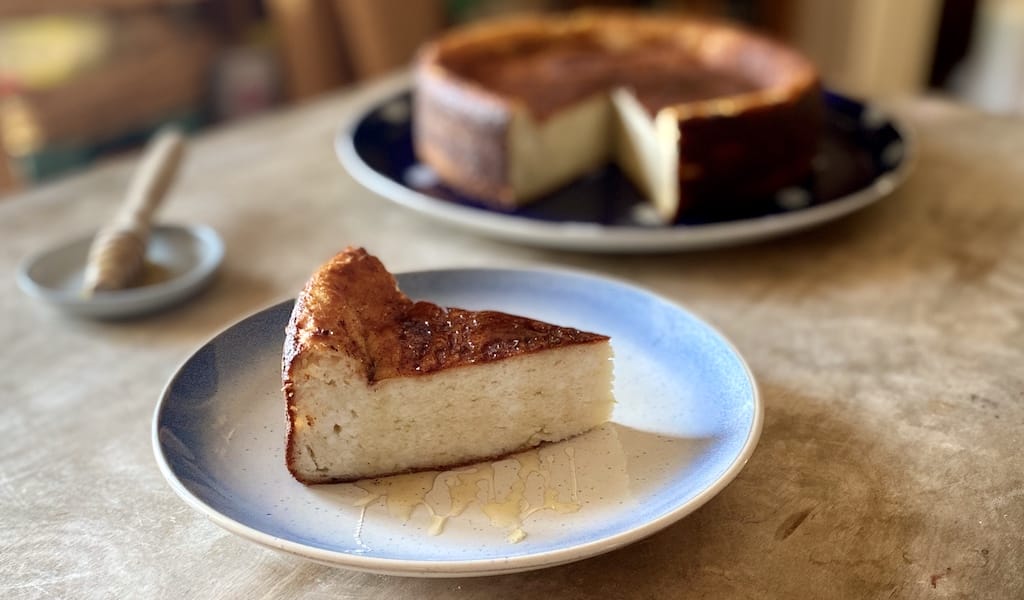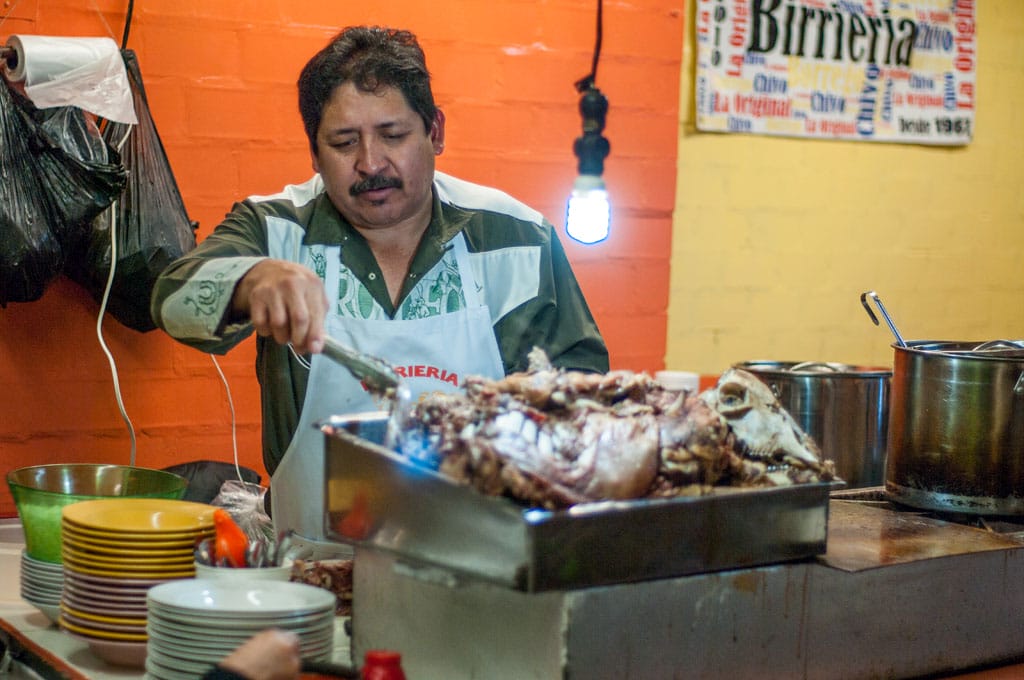Pastory is located on Via Sammartino, in an affluent area of Palermo; however, this fresh pasta shop has its roots in revolution.
It all began in 1968, a year marked by emancipatory struggles in France and beyond, which were reshaping societal norms and providing women with new avenues for participation and empowerment. Inspired by this transformative era, Serena Sabatino’s grandmother, Angelina di Carluccio, made the decision to migrate from Naples to Palermo. Accompanied by her husband, Raffaele Sabatino, who had secured employment in Sicily, Angelina brought with her a wealth of knowledge about the Neapolitan art of pasta fresca all’uovo (fresh egg pasta).
![Pastory is located on Via Sammartino, in an affluent area of Palermo; however, this fresh pasta shop has its roots in revolution. It all began in 1968, a year marked by emancipatory struggles in France and beyond, which were reshaping societal norms and providing women with new avenues for participation and empowerment. Inspired by this transformative era, Serena Sabatino's grandmother, Angelina di Carluccio, made the decision to migrate from Naples to Palermo. Accompanied by her husband, Raffaele Sabatino, who had secured employment in Sicily, Angelina brought with her a wealth of knowledge about the Neapolitan art of pasta fresca all'uovo (fresh egg pasta). Photo: serena Caption: Serena Sabatino, Pastory, Palermo, photo by Ségolène Bulot While the tradition of making fresh pasta already existed in Sicily, it was confined to home kitchens. Serena explains: “In 1968, there were women, grandmothers and mothers in Palermo who would prepare fresh pasta at home, but there was no shop that offered it. My grandmother introduced something groundbreaking and opened Past’ovo – a pasta factory that cleverly combined the essential elements of pasta and uovo [egg] – right on Via Giovianni Alfredo Cesareo. The choice of 1968 as the inauguration date for this establishment is a clear reflection of her revolutionary spirit and her alignment with the feminist movement of that era." Captivated by Angelina’s indomitable spirit, several women in the family business became involved in the fresh pasta business. Photo: inside Caption: Pastory, Palermo, photo by Ségolène Bulot Inspired by her grandmother’s legacy, Serena Sabatino and Tamara Bertone opened Pastory in June 2021, taking the concept of fresh pasta to a whole new level. Expanding upon the success of their pasta factory – which continues to produce fresh noodles – they set their sights on creating an inviting restaurant where they could also serve up traditional pasta dishes with a contemporary twist, breathing new life into time-honored recipes. Serena graduated with a degree in psychology, and wanted to combine her understanding of that discipline with the culinary arts, not just in terms of the food she cooks and serves but also with respect to team management. Tamara, the co-founder of Pastory, had traveled extensively in her previous job as a retail sales manager. “The neighborhood is quite interesting,” she says of Pastory’s location. “I could see it from the perspective of someone who has been abroad and come back. There were no restaurants around, it’s changed only recently – it’s great to think we have been at the very epicenter of this shift, pioneering the winds of change from [the restaurant’s] very inception.” Photo: team Caption: Pastory, Palermo, photo by Ségolène Bulot In the kitchen, two local chefs, Manfredi Mancini and Daniele lo Galbo, are joined by Safikul Bepari, the newest addition to the team. Through local programs fostering professional integration for migrants, the restaurant has welcomed Sakiful, from Bangladesh, and helped him adapt his skills for the local market. "Even though things can get a bit hectic during peak hours, what I truly cherish about this place is the absence of routine,” he says. “We are constantly exploring new culinary horizons, experimenting with fresh ideas and novel combinations of ingredients." Together, the team has come up with a signature dish: L'unione fa la scorza. The name refers to the age-old adage "union is strength" with a clever nod to the invigorating essence of orange and lemon zest – also called scorza in Italian. This citrus pesto features orange, mandarins, lemon, walnuts, almonds, pistachios, basil, oil, and garlic. At Pastory, you have the freedom to choose from a variety of seven pasta types to pair with this tantalizing pesto (among other sauces), and you can even take it a step further by adding unique, palate-pleasing toppings. It's important to remember, though, that in the world of Italian cuisine, there are certain sacred principles, and one of them is the perfect marriage of pasta and sauce. So, while your creativity is celebrated, don't be surprised if neighboring Italian diners raise an eyebrow or two – after all, pasta and sauce combinations are a matter of great importance. When savoring L'unione fa la scorza, Serena's recommendation is to pair it with pasta varieties like bigoli or casarecce, as their distinctive textures make them ideal for holding onto the delightful sauce. Photo: dish Caption: Pasta alla Norma, Pastory, Palermo, photo by Ségolène Bulot For those who lean towards the classics, you'll find comfort in the selection of traditional recipes at Pastory. The menu includes the famous Sicilian pasta alla norma, a pasta with tomatoes, aubergines and grated, salty ricotta, and, some of the most popular Neapolitan recipes, as a nod to the family’s origins. Both Maria Letizia and Angelina, Serena’s mother and grandmother have passed down recipes such as pasta e fagioli – a typical recipe in which a mix of different pasta is cooked together with beans – and a reinterpretation of the most popular Neapolitan panino (sandwich), made with friarielli (Italian bitter greens), salsiccia (sausage) and provola (a southern Italian cheese). Photo: pasta Caption: Pastory, Palermo, photo by Ségolène Bulot These dishes are a fitting tribute to the women who inspired the creation of Pastory. “As we look back, we do not want to be passive bystanders, but fierce trailblazers who etch their own mark. My grandmother was there and has been part of this revolution in her way,” says Serena. “And today, we are doing the same, in the heart of the kitchen, stirring up a storm of transformation.”](https://images.culinarybackstreets.com/wp-content/uploads/cb_Palermo_pastory_S.B_serena.jpeg?lossy=1&resize=800%2C600&ssl=1)
While the tradition of making fresh pasta already existed in Sicily, it was confined to home kitchens. Serena explains: “In 1968, there were women, grandmothers and mothers in Palermo who would prepare fresh pasta at home, but there was no shop that offered it. My grandmother introduced something groundbreaking and opened Past’ovo – a pasta factory that cleverly combined the essential elements of pasta and uovo [egg] – right on Via Giovianni Alfredo Cesareo. The choice of 1968 as the inauguration date for this establishment is a clear reflection of her revolutionary spirit and her alignment with the feminist movement of that era.” Captivated by Angelina’s indomitable spirit, several women in the family business became involved in the fresh pasta business.
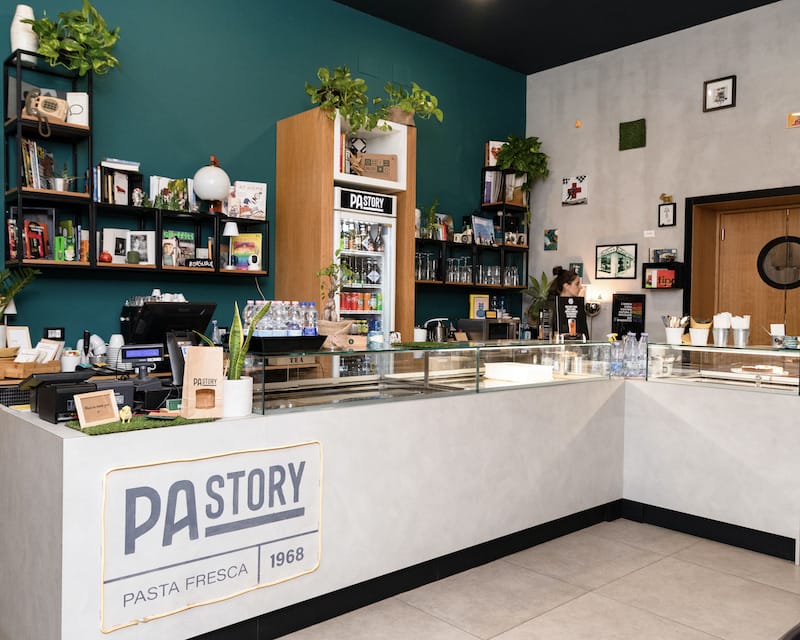
Inspired by her grandmother’s legacy, Serena Sabatino and Tamara Bertone opened Pastory in June 2021, taking the concept of fresh pasta to a whole new level. Expanding upon the success of their pasta factory – which continues to produce fresh noodles – they set their sights on creating an inviting restaurant where they could also serve up traditional pasta dishes with a contemporary twist, breathing new life into time-honored recipes.
Serena graduated with a degree in psychology, and wanted to combine her understanding of that discipline with the culinary arts, not just in terms of the food she cooks and serves but also with respect to team management. Tamara, the co-founder of Pastory, had traveled extensively in her previous job as a retail sales manager. “The neighborhood is quite interesting,” she says of Pastory’s location. “I could see it from the perspective of someone who has been abroad and come back. There were no restaurants around, it’s changed only recently – it’s great to think we have been at the very epicenter of this shift, pioneering the winds of change from [the restaurant’s] very inception.”
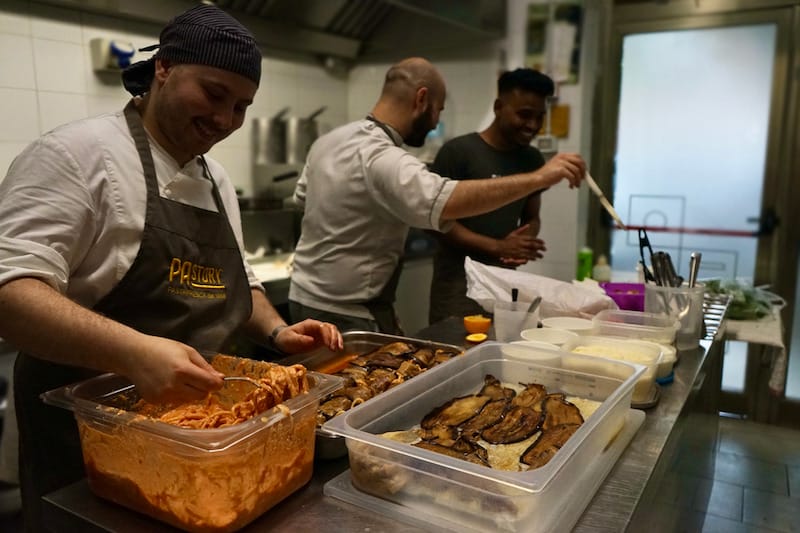
In the kitchen, two local chefs, Manfredi Mancini and Daniele lo Galbo, are joined by Safikul Bepari, the newest addition to the team. Through local programs fostering professional integration for migrants, the restaurant has welcomed Sakiful, from Bangladesh, and helped him adapt his skills for the local market. “Even though things can get a bit hectic during peak hours, what I truly cherish about this place is the absence of routine,” he says. “We are constantly exploring new culinary horizons, experimenting with fresh ideas and novel combinations of ingredients.“
Together, the team has come up with a signature dish: L’unione fa la scorza. The name refers to the age-old adage “union is strength” with a clever nod to the invigorating essence of orange and lemon zest – also called scorza in Italian. This citrus pesto features orange, mandarins, lemon, walnuts, almonds, pistachios, basil, oil, and garlic. At Pastory, you have the freedom to choose from a variety of seven pasta types to pair with this tantalizing pesto (among other sauces), and you can even take it a step further by adding unique, palate-pleasing toppings. It’s important to remember, though, that in the world of Italian cuisine, there are certain sacred principles, and one of them is the perfect marriage of pasta and sauce. So, while your creativity is celebrated, don’t be surprised if neighboring Italian diners raise an eyebrow or two – after all, pasta and sauce combinations are a matter of great importance. When savoring L’unione fa la scorza, Serena’s recommendation is to pair it with pasta varieties like bigoli or casarecce, as their distinctive textures make them ideal for holding onto the delightful sauce.
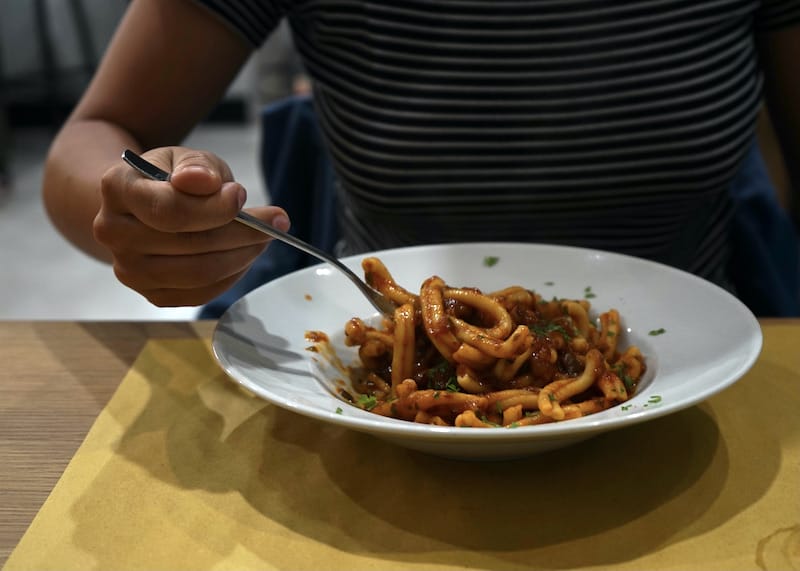
For those who lean towards the classics, you’ll find comfort in the selection of traditional recipes at Pastory. The menu includes the famous Sicilian pasta alla norma, a pasta with tomatoes, aubergines and grated, salty ricotta, and, some of the most popular Neapolitan recipes, as a nod to the family’s origins. Both Maria Letizia and Angelina, Serena’s mother and grandmother have passed down recipes such as pasta e fagioli – a typical recipe in which a mix of different pasta is cooked together with beans – and a reinterpretation of the most popular Neapolitan panino (sandwich), made with friarielli (Italian bitter greens), salsiccia (sausage) and provola (a southern Italian cheese).
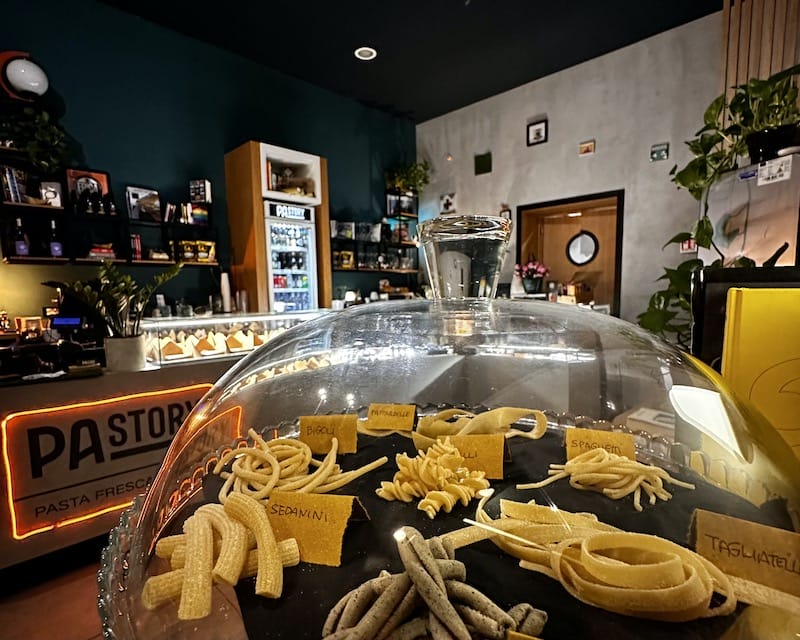
These dishes are a fitting tribute to the women who inspired the creation of Pastory. “As we look back, we do not want to be passive bystanders, but fierce trailblazers who etch their own mark. My grandmother was there and has been part of this revolution in her way,” says Serena. “And today, we are doing the same, in the heart of the kitchen, stirring up a storm of transformation.”
 August 11, 2015 Country Dining
August 11, 2015 Country Dining
As in many other rural parts of Europe, the Catalonian countryside is dotted with large, […] Posted in Barcelona September 25, 2020 Recipe
September 25, 2020 Recipe
Did you know that the idea of a cheesecake is centuries old? In his book Cheesecake […] Posted in Athens January 27, 2016 CB on the Road
January 27, 2016 CB on the Road
Although, thanks to its once flourishing silver and gold mines, the north-central […] Posted in Mexico City
Ségolène BulotSégolène Bulot
Published on November 16, 2023
Related stories
August 11, 2015
BarcelonaAs in many other rural parts of Europe, the Catalonian countryside is dotted with large, old farmhouses, legacies of feudalism that have since been converted into hotels, bed-and-breakfasts and restaurants. The origins of these masías, as they’re known in Catalan, go back to the 11th century, but it was not until the end of feudalism…
September 25, 2020
AthensDid you know that the idea of a cheesecake is centuries old? In his book Cheesecake Madness (Simon & Schuster, 1984), John Segreto writes that, according to his research, the first cheesecake was documented between 800 to 700 B.C. on the island of Samos; other scholars, having studied ancient cheese molds and other findings unearthed…
January 27, 2016
Mexico CityAlthough, thanks to its once flourishing silver and gold mines, the north-central Mexican state of Zacatecas was an economic powerhouse during the colonial period and the early years of the Mexican republic, its cuisine is not as well known in Mexico City as that of states such as Oaxaca and Michoacán. But when we headed…







































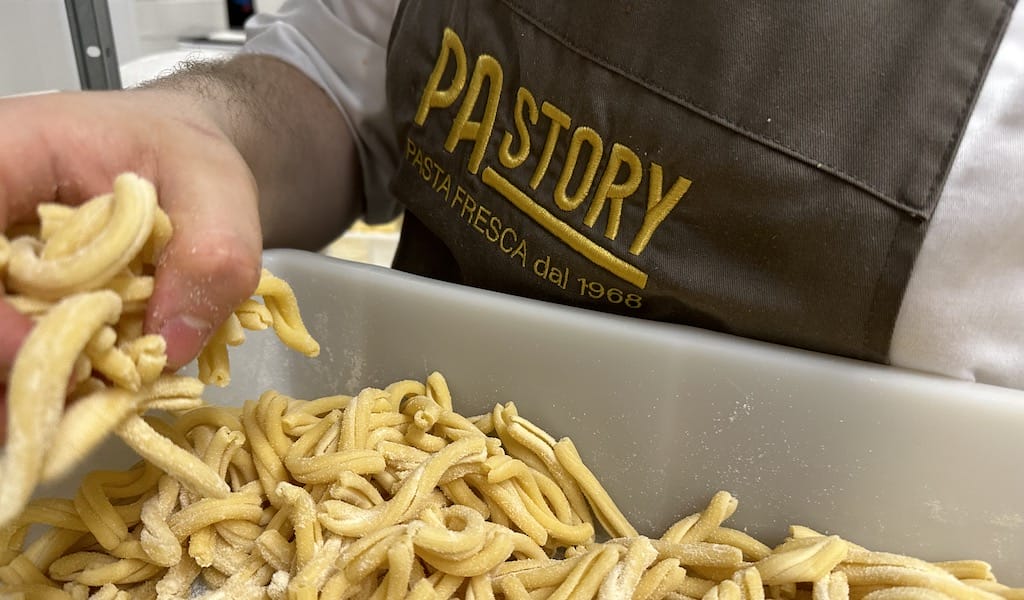

![Pastory is located on Via Sammartino, in an affluent area of Palermo; however, this fresh pasta shop has its roots in revolution. It all began in 1968, a year marked by emancipatory struggles in France and beyond, which were reshaping societal norms and providing women with new avenues for participation and empowerment. Inspired by this transformative era, Serena Sabatino's grandmother, Angelina di Carluccio, made the decision to migrate from Naples to Palermo. Accompanied by her husband, Raffaele Sabatino, who had secured employment in Sicily, Angelina brought with her a wealth of knowledge about the Neapolitan art of pasta fresca all'uovo (fresh egg pasta). Photo: serena Caption: Serena Sabatino, Pastory, Palermo, photo by Ségolène Bulot While the tradition of making fresh pasta already existed in Sicily, it was confined to home kitchens. Serena explains: “In 1968, there were women, grandmothers and mothers in Palermo who would prepare fresh pasta at home, but there was no shop that offered it. My grandmother introduced something groundbreaking and opened Past’ovo – a pasta factory that cleverly combined the essential elements of pasta and uovo [egg] – right on Via Giovianni Alfredo Cesareo. The choice of 1968 as the inauguration date for this establishment is a clear reflection of her revolutionary spirit and her alignment with the feminist movement of that era." Captivated by Angelina’s indomitable spirit, several women in the family business became involved in the fresh pasta business. Photo: inside Caption: Pastory, Palermo, photo by Ségolène Bulot Inspired by her grandmother’s legacy, Serena Sabatino and Tamara Bertone opened Pastory in June 2021, taking the concept of fresh pasta to a whole new level. Expanding upon the success of their pasta factory – which continues to produce fresh noodles – they set their sights on creating an inviting restaurant where they could also serve up traditional pasta dishes with a contemporary twist, breathing new life into time-honored recipes. Serena graduated with a degree in psychology, and wanted to combine her understanding of that discipline with the culinary arts, not just in terms of the food she cooks and serves but also with respect to team management. Tamara, the co-founder of Pastory, had traveled extensively in her previous job as a retail sales manager. “The neighborhood is quite interesting,” she says of Pastory’s location. “I could see it from the perspective of someone who has been abroad and come back. There were no restaurants around, it’s changed only recently – it’s great to think we have been at the very epicenter of this shift, pioneering the winds of change from [the restaurant’s] very inception.” Photo: team Caption: Pastory, Palermo, photo by Ségolène Bulot In the kitchen, two local chefs, Manfredi Mancini and Daniele lo Galbo, are joined by Safikul Bepari, the newest addition to the team. Through local programs fostering professional integration for migrants, the restaurant has welcomed Sakiful, from Bangladesh, and helped him adapt his skills for the local market. "Even though things can get a bit hectic during peak hours, what I truly cherish about this place is the absence of routine,” he says. “We are constantly exploring new culinary horizons, experimenting with fresh ideas and novel combinations of ingredients." Together, the team has come up with a signature dish: L'unione fa la scorza. The name refers to the age-old adage "union is strength" with a clever nod to the invigorating essence of orange and lemon zest – also called scorza in Italian. This citrus pesto features orange, mandarins, lemon, walnuts, almonds, pistachios, basil, oil, and garlic. At Pastory, you have the freedom to choose from a variety of seven pasta types to pair with this tantalizing pesto (among other sauces), and you can even take it a step further by adding unique, palate-pleasing toppings. It's important to remember, though, that in the world of Italian cuisine, there are certain sacred principles, and one of them is the perfect marriage of pasta and sauce. So, while your creativity is celebrated, don't be surprised if neighboring Italian diners raise an eyebrow or two – after all, pasta and sauce combinations are a matter of great importance. When savoring L'unione fa la scorza, Serena's recommendation is to pair it with pasta varieties like bigoli or casarecce, as their distinctive textures make them ideal for holding onto the delightful sauce. Photo: dish Caption: Pasta alla Norma, Pastory, Palermo, photo by Ségolène Bulot For those who lean towards the classics, you'll find comfort in the selection of traditional recipes at Pastory. The menu includes the famous Sicilian pasta alla norma, a pasta with tomatoes, aubergines and grated, salty ricotta, and, some of the most popular Neapolitan recipes, as a nod to the family’s origins. Both Maria Letizia and Angelina, Serena’s mother and grandmother have passed down recipes such as pasta e fagioli – a typical recipe in which a mix of different pasta is cooked together with beans – and a reinterpretation of the most popular Neapolitan panino (sandwich), made with friarielli (Italian bitter greens), salsiccia (sausage) and provola (a southern Italian cheese). Photo: pasta Caption: Pastory, Palermo, photo by Ségolène Bulot These dishes are a fitting tribute to the women who inspired the creation of Pastory. “As we look back, we do not want to be passive bystanders, but fierce trailblazers who etch their own mark. My grandmother was there and has been part of this revolution in her way,” says Serena. “And today, we are doing the same, in the heart of the kitchen, stirring up a storm of transformation.”](https://images.culinarybackstreets.com/wp-content/uploads/cb_Palermo_pastory_S.B_serena.jpeg?lossy=1&resize=800%2C600&ssl=1)








